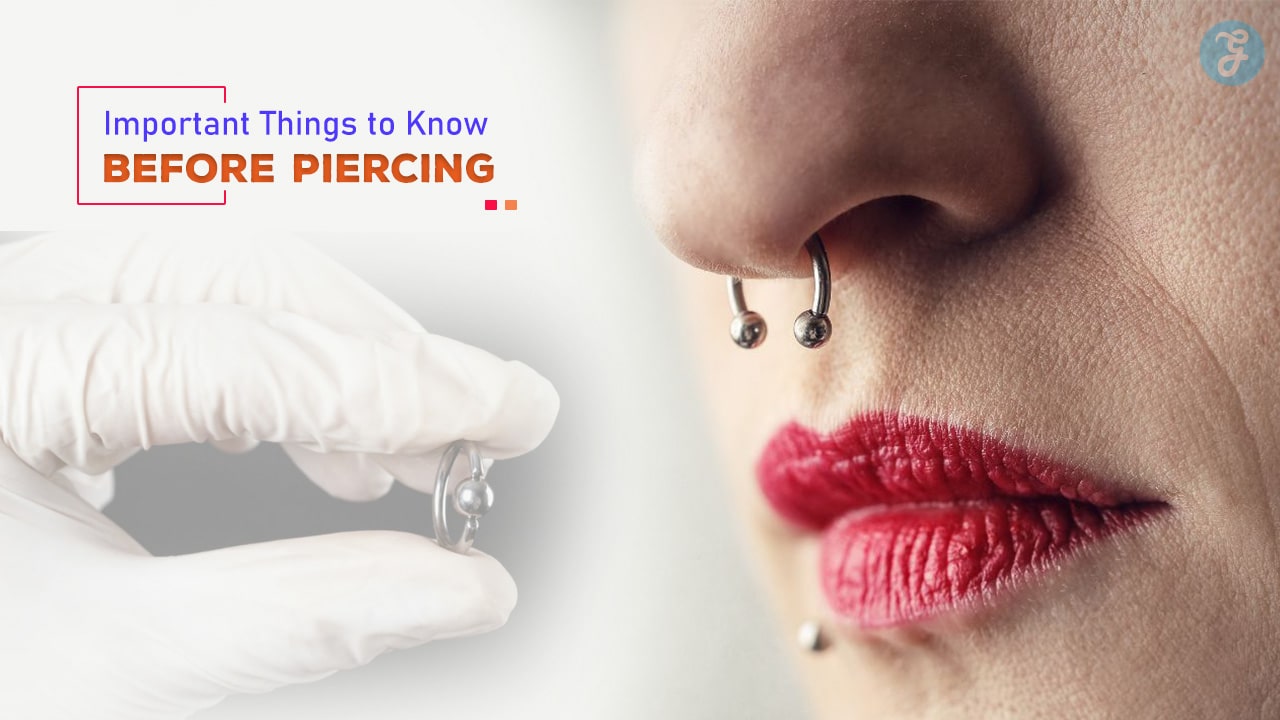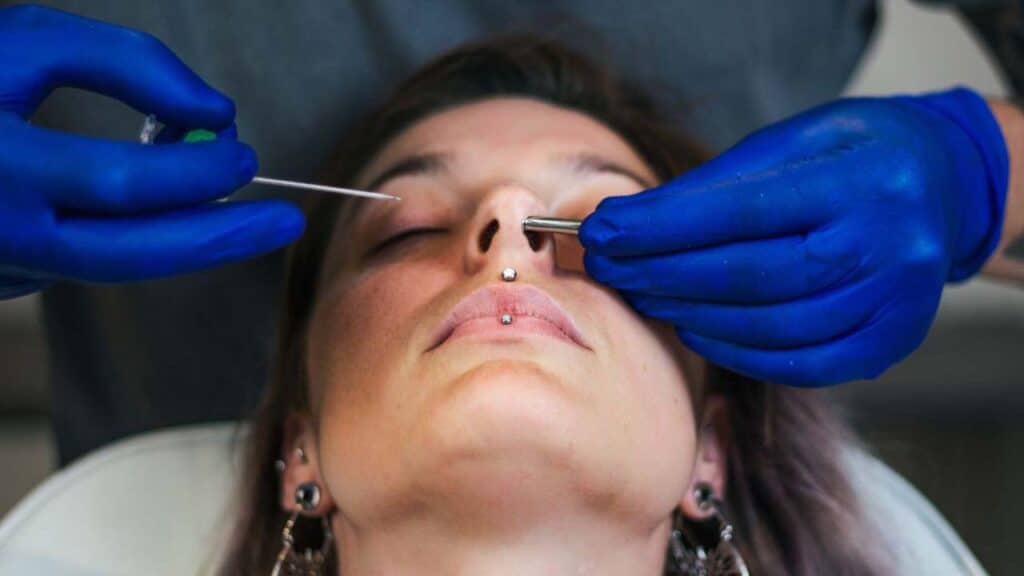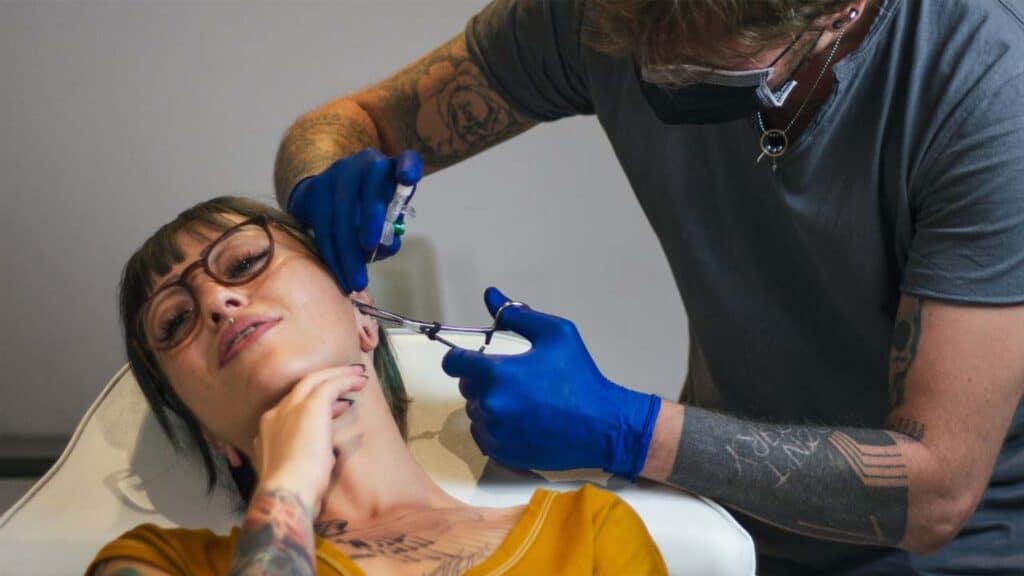Getting a piercing is an exciting way to express your individuality and style, but it’s important to be well informed before taking the plunge.
Whether it’s your first time or you’re adding to an existing collection, piercing involves more than just choosing a location and jewelry.
Knowing the process, understanding aftercare, and selecting a professional piercer are just a few of the critical steps in ensuring a safe and successful piercing experience.
In this detailed guide, we’ll walk you through the 15 important things to know before getting a piercing so you can make informed decisions and enjoy your new body art with confidence.
1. Choose the Right Piercing Location
Before getting a piercing, it’s crucial to choose the right spot on your body.
Different piercings have varying pain levels, healing times, and potential impacts on your lifestyle.
For example, ear lobes are relatively easy to pierce and heal quickly, while cartilage or nose piercings may require more aftercare and healing time.
How to decide:
Think about your pain tolerance, how visible you want your piercing to be, and how it might affect your daily life.
For example, if you work in a conservative environment, facial piercings may not be ideal.
On the other hand, ear, belly button, or even dermal piercings can be more easily concealed.
Research different types of piercings to understand what each entails and how it fits with your personal style and routine.
Why it’s important:
Choosing the right location will ensure that you’re comfortable with your piercing during the healing process and beyond.
Considering practical aspects like pain, healing time, and work or lifestyle restrictions can prevent future regret.
2. Find a Reputable Piercing Studio
One of the most important things to know before getting a piercing is how to choose a professional studio.
Not all piercing shops maintain the same hygiene standards, and it’s critical to find a licensed, reputable studio that follows proper sterilization procedures.
How to research:
Look for piercing studios with good reviews and a professional atmosphere.
Visit the shop beforehand to ensure it’s clean and follows sanitation protocols like using single-use needles and sterilizing equipment.
Ask the piercer about their experience, certifications, and the types of piercings they specialize in.
A professional piercer will be happy to answer your questions and put your mind at ease.
Why it’s important:
A clean, professional environment significantly reduces the risk of infection and complications.
Choosing a well-trained piercer also ensures that the procedure is done safely and correctly, leading to better healing and overall satisfaction.
3. Understand the Piercing Process
Knowing what happens during the piercing process can help reduce anxiety and prepare you for the experience.
The process typically involves marking the area, using a sterilized needle to create the hole, and inserting the jewelry.
How to prepare:
Before your appointment, ensure that you are hydrated and have eaten a light meal to avoid feeling faint.
When you arrive, the piercer will mark the location with a sterile marker and ask for your approval.
They will then use a sterile needle to perform the piercing (never allow a piercer to use a piercing gun for anything other than earlobes).
The jewelry will be inserted immediately, and the piercer will go over aftercare instructions with you.
Why it’s important:
Knowing what to expect during the piercing process can help calm your nerves and ensure you’re fully prepared.
Understanding the steps involved also allows you to spot any potential red flags, such as improper hygiene or unprofessional behavior.
4. Choose the Right Jewelry
Choosing the right jewelry for your piercing is essential for both aesthetic reasons and the health of your piercing.
The material, size, and style of your jewelry can significantly impact the healing process.
How to choose:
Opt for high-quality, hypoallergenic materials like titanium, surgical steel, or 14k gold, which are less likely to cause irritation or allergic reactions.
Avoid cheap or nickel-based jewelry, which can lead to infections or metal sensitivities.
Your piercer will help you choose the correct size and style of jewelry, ensuring it fits properly and allows room for swelling.
Why it’s important:
Using high-quality materials reduces the risk of infection, allergic reactions, and rejection.
Properly fitted jewelry also ensures that your piercing heals correctly, preventing complications like excessive swelling or migration.
5. Be Prepared for the Healing Process
Every piercing comes with a healing period, and it’s important to be patient during this time.
Healing times can range from a few weeks to several months, depending on the location and care you provide.
How to prepare:
Piercings like ear lobes typically heal within 4-6 weeks, while cartilage, nose, and navel piercings can take anywhere from 3-9 months to fully heal.
During the healing process, avoid touching the piercing with unwashed hands and keep the area clean using a saline solution.
Be careful when changing clothes, brushing your hair, or engaging in physical activities that could irritate the area.
Why it’s important:
Understanding the healing timeline helps you manage your expectations and ensures you don’t rush the process.
Giving your piercing the proper care and time it needs to heal will result in a healthy, long-lasting piercing.
6. Follow Proper Aftercare
Aftercare is one of the most crucial aspects of ensuring that your piercing heals properly.
Neglecting aftercare can lead to infections, scarring, or even piercing rejection.
How to implement:
Use a saline solution (either store-bought or homemade using sea salt and distilled water) to clean your piercing 2-3 times a day.
Avoid using alcohol or hydrogen peroxide, as these can dry out and damage the skin.
Don’t touch your piercing with dirty hands, and avoid swimming in pools, hot tubs, or oceans during the healing process, as these environments can introduce bacteria to the area.
Why it’s important:
Proper aftercare significantly reduces the risk of infection and promotes faster healing.
Following aftercare guidelines ensures that your piercing remains healthy and looks its best once fully healed.
7. Be Aware of Possible Side Effects
While most piercings heal without issue, it’s important to be aware of potential side effects.
Common side effects include swelling, redness, and tenderness, but in some cases, complications like infections or allergic reactions can occur.
How to manage:
It’s normal to experience slight swelling and redness in the days following your piercing.
However, if you notice excessive swelling, pus, intense pain, or a fever, these may be signs of an infection, and you should contact your piercer or a medical professional immediately.
For allergic reactions, switching to hypoallergenic jewelry (such as titanium or surgical steel) can alleviate symptoms.
Why it’s important:
Knowing the possible side effects ensures you can take quick action if something goes wrong.
Being informed about complications helps you address them early, preventing more serious issues.
8. Avoid Piercing Guns for Anything Other Than Earlobes
Piercing guns are commonly used for earlobe piercings in retail settings, but they are not recommended for other types of piercings.
The force of a piercing gun can cause trauma to the tissue, especially in cartilage areas, leading to complications.
How to avoid:
If you’re getting anything other than a simple earlobe piercing, insist on a needle.
Professional piercers use sterilized, hollow needles that make a clean, controlled incision, reducing the risk of tissue damage and infection.
Never allow a piercer to use a gun on areas like the nose, cartilage, or navel.
Why it’s important:
Piercing guns can cause unnecessary trauma and increase the risk of infection, especially in delicate areas.
Using a sterile needle for your piercing ensures that the procedure is done safely and with minimal tissue damage.
9. Plan for Swelling and Sensitivity
Most piercings, especially those in cartilage or sensitive areas, will cause some swelling and sensitivity in the days following the procedure.
It’s important to plan for this discomfort and take steps to minimize it.
How to manage:
Be prepared for your piercing to swell slightly, and choose jewelry that allows room for this.
For the first few days, apply cold compresses to the area to reduce swelling, and avoid activities that may irritate the piercing, such as wearing tight clothing or sleeping on the pierced side.
Over-the-counter anti-inflammatory medications can also help manage swelling and pain.
Why it’s important:
Swelling and sensitivity are natural parts of the healing process, but preparing for them can make the experience more comfortable.
Choosing appropriate jewelry and following aftercare tips will help keep swelling under control and minimize discomfort.
10. Consider Your Lifestyle
Before getting a piercing, consider how it might affect your daily life.
Certain piercings, such as lip, tongue, or nose piercings, may require you to make changes to your routine or avoid specific activities.
How to prepare:
For oral piercings like lip or tongue piercings, you’ll need to be careful with eating, drinking, and speaking during the initial healing period.
Nose or septum piercings may require extra care when blowing your nose or during allergy season.
If you’re an athlete, think about how tight clothing and physical activity might affect a belly button or nipple piercing.
Why it’s important:
Planning ahead and understanding how your piercing might impact your lifestyle can prevent inconvenience or complications during the healing process.
Taking these factors into account ensures you’re fully prepared to care for your new piercing.
11. Don’t Rush the Healing Process
One of the most common mistakes people make is rushing the healing process by changing their jewelry too soon or neglecting aftercare once the piercing appears to be healed on the outside.
How to avoid:
Each type of piercing has a different healing timeline, so be patient.
Even if your piercing looks healed on the outside, the internal tissue may still be healing.
Follow your piercer’s instructions about when it’s safe to change jewelry—usually 6-8 weeks for earlobes and 3-6 months for cartilage or nose piercings.
Continuing aftercare practices, such as cleaning with saline solution, until the piercing is fully healed will ensure the best outcome.
Why it’s important:
Rushing the healing process can lead to infections, scarring, or jewelry rejection.
Giving your piercing the time it needs to heal fully will result in a healthy, long-lasting body modification.
12. Know the Signs of Infection
While infections are relatively rare with proper aftercare, they can happen.
Knowing the signs of an infected piercing can help you address the issue before it becomes more serious.
How to identify:
Common signs of infection include intense redness, excessive swelling, pus discharge (yellow or green), throbbing pain, or a fever.
If you suspect your piercing is infected, contact your piercer or a healthcare professional immediately.
They may recommend cleaning the area more frequently with saline solution or prescribe antibiotics if necessary.
Why it’s important:
Recognizing the signs of infection early allows you to take action and prevent further complications.
Quick treatment ensures that the infection doesn’t worsen and that your piercing remains healthy.
13. Understand the Risks of Rejection and Migration
Rejection and migration are risks with certain types of piercings, especially surface piercings.
These occur when the body treats the jewelry as a foreign object and slowly pushes it out, or when the piercing moves from its original placement.
How to recognize:
If your piercing begins to shift or the skin around the piercing becomes thin, this may be a sign of migration.
Rejection can occur if the jewelry is too large, the piercing was placed too shallow, or your body simply reacts negatively to the foreign object.
If you suspect your piercing is being rejected, visit your piercer for advice.
Why it’s important:
Rejection and migration can lead to scarring or loss of the piercing altogether.
Being aware of the risks and choosing an experienced piercer can reduce the likelihood of these complications.
14. Consider Allergies and Sensitivities
Metal allergies, particularly to nickel, can cause irritation and prevent your piercing from healing properly.
It’s important to choose hypoallergenic materials that are safe for your skin.
How to choose:
If you have known metal allergies, opt for jewelry made from biocompatible materials like titanium, surgical steel, or 14k gold.
Avoid cheap, plated, or nickel-based metals, which are more likely to cause allergic reactions or skin irritation.
Your piercer can help you choose the best material for your specific needs.
Why it’s important:
Choosing the right jewelry material prevents allergic reactions and ensures your piercing heals correctly.
High-quality materials are not only safer but also more durable, reducing the risk of infection and other complications.
15. Know When to Seek Professional Help
If something feels off with your piercing or if you’re unsure about its healing process, don’t hesitate to seek professional advice.
Whether it’s a question about aftercare or a concern about infection, visiting your piercer or a healthcare provider is always the best course of action.
How to proceed:
If you notice anything unusual—such as abnormal swelling, pain, or discharge—contact your piercer or doctor.
They can assess the situation and recommend the best treatment options, whether that’s adjusting your jewelry, cleaning the piercing, or prescribing medication.
Why it’s important:
Being proactive about your piercing’s health ensures that any issues are addressed before they become more serious.
Seeking professional advice can prevent complications and ensure that your piercing heals properly.
Final Thoughts
Getting a piercing is an exciting way to express your personal style, but it requires proper planning and care.
By considering these 15 important things to know before getting a piercing, you’ll be better prepared for the procedure, the healing process, and how to care for your new body art.
From choosing the right studio to understanding aftercare, these tips will ensure your piercing experience is safe, successful, and stylish.













































